Our 10 best photos of 2018
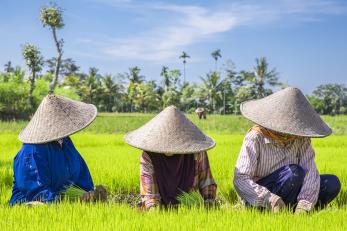
By Ezra Millstein, senior content producer
Mercy Corps has always taken particular pride in our photography, embracing the philosophy that it is a crucial way to share stories and connect people around the world. I was told when I started working here how important photography is to the organization — it’s the palette of the stories we tell. This idea goes beyond just light, color and composition — our photographs strive to serve as a visual manifestation of both the challenges faced by the people we work with, and the work we do to help them build better lives. I’ve seen firsthand the incredible work of our teams on the ground, and how people like you are making an impact for families around the world every day.
2018 was my first full year working as Mercy Corps’ in-house photographer. I flew 167,000 miles, shot over 70,000 photos, and along with our cadre of freelance photographers, created images of our work in 15 countries. From assisting those affected by the humanitarian crisis in Yemen, to responding to the impact of climate change, I feel fortunate to have this incredible perspective on the breadth and importance of our work.
These 10 most visually compelling photos from 2018 show the struggles that people face and their resilience in overcoming them. They also represent our geographic and programmatic diversity, as well as some of the most innovative and lifesaving work that Mercy Corps is doing around the world.
February 2018, Nairobi, Kenya
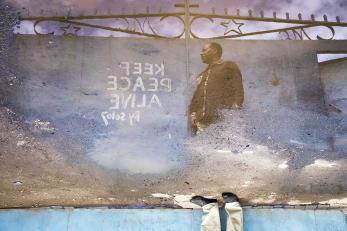
Joseph's house was looted and burned during the 2007-8 post-election violence that engulfed Kenya and left hundreds dead. Rather than stew in resentment, he decided to join a peace movement to prevent such violence from happening again. He works in partnership with Mercy Corps’ to help defuse tension before it can break out into full-fledged violence.
I am always drawn to reflections in photos. On this rainy afternoon, when Chairman Mbunga stood in front of an apt slogan painted beside a crowded street in the Kibera slum, I couldn’t resist capturing it in a puddle at his feet.
March 2018, Chyamrangbesi, Nepal
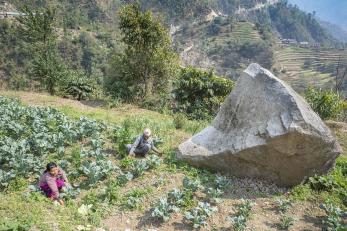
Sabitri and her husband, Shyam, work in their vegetable fields near one of the many boulders that rained down on their village during the earthquake of 2015. The earthquake triggered a landslide that wiped out their fields and made it unsafe for them to live in their home. They lived in a temporary shelter with four other families for nine months. They couldn’t work until Mercy Corps built a gabion wall that secured the hillside above the couple’s home. After the wall was built, Shyam and Sabitri finally felt safe enough to return and begin rebuilding their lives.
This photo resonates with me personally, as I was in Nepal when the earthquake struck and experienced firsthand what it feels like to have the earth move beneath you and watch everything crumble around you. It’s inspiring to see how people have recovered since then. The size of the boulders in this photo brings to life what it must have felt like to suddenly have large pieces of a mountain falling on your home.
May 2018, Terara, Indonesia

These women are transplanting rice seedlings. They are members of a farmers group supported by Mercy Corps, which is helping them learn how to grow stronger, heartier crops in the face of worsening drought. Lombok is extremely vulnerable to climate change and is experiencing shorter rainy seasons and longer dry seasons that put harvests at risk. Three months to the day after this photo was taken, Mercy Corps responded to a 6.9 magnitude earthquake in Lombok, which killed more than 500 people and displaced more than 417,000 others. It was the deadliest and strongest earthquake to hit the island in recorded history.
We were lucky to spend a full day with this group, seeing all stages of rice planting, transplanting and harvesting. The key to most good photographs is the subject’s eyes, but in this case that is outweighed by the symmetry of the image. The vibrant tropical greens tie everything together.
August 2018, Sidon, Lebanon
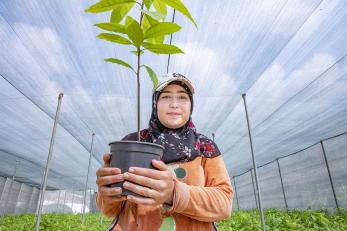
This avocado farm in southern Lebanon sells seedlings to local farmers. Mercy Corps helped provide an irrigation system that helped the business plant an additional 24,000 trees and hire new farmers, including several Syrian refugees like Moufideh.
We always try to use photography to demonstrate the strength and resilience of our beneficiaries, which often involves shooting up toward them. This can be a challenge in the light of midday, which is why I took full advantage of having this thin cloth greenhouse roof overhead.
July 2018, Goma, Democratic Republic of Congo

Jessica, 18, takes part in a girls club session on how to make reusable and low cost menstrual pads, which both improves health and serves as an income generating opportunity. In Goma, Mercy Corps supports several of these clubs — each includes about twenty members between the ages of 13 and 24. They provide a safe space for girls to discuss issues including health, hygiene and gender-based violence, and empowers them to have a stronger voice in their community.
It has been said that there are two people in every portrait, the subject and the photographer. You can clearly see the rapport that photographer Elizabeth Dalziel has established with Jessica, leading to this warm and genuine smile.
July 2018, Zaatari, Jordan
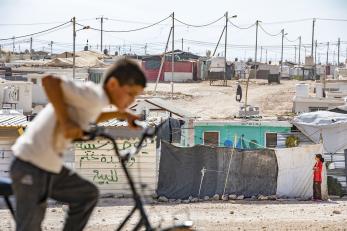
Children play on the outskirts of Zaatari refugee camp. Mercy Corps operates a safe space inside Zaatari where Syrian refugees learn about healthy parenting strategies and make traditional Syrian crafts that help them stay connected to home. The space, which features a playground, garden, soccer field, and classrooms, gives adults and children a comfortable place to stay in the middle of the dusty camp. This photo shows the density and scale of Zaatari camp, where 78,000 people still live after eight years of Syrian conflict — 20 percent of those are children under 5.
August 2018, Ventimiglia, Italy
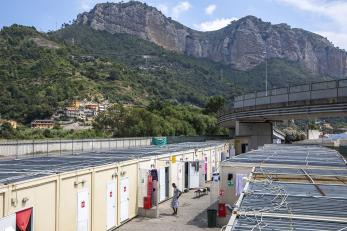
Roya camp sits near the border of France and Italy, and is a spot where migrants often get stranded as they try to make their way into Europe. Far from home and with few resources, survival and staying in touch with family back home is a challenge for those who end up here. Mercy Corps partnered with Cisco to install a WiFi network at the camp, helping people get crucial information and feel less alone.
This was a striking location. Seeing refugees living in storage containers under an abandoned overpass, only a stone’s throw from the sparkling beaches and verdant hills of the Italian Riviera, truly epitomizes the inequality that refugees face. The man standing alone in the center of the camp is emblematic of how alone someone can feel living in the camp, even though they may be surrounded by crowds of people.
September 2018, Al Mahweet, Yemen
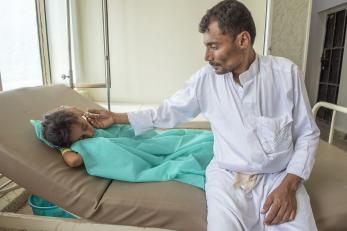
Abdullah sits on the bed of his 7-year-old daughter Nehan in a cholera isolation unit where Nehan has just begun receiving treatment. Abdullah is a banana farmer, and the father of seven children. Mercy Corps is providing several Yemeni cholera treatment centers with clean water, equipment and other much-needed medical supplies.
This quiet, intimate moment between a father and daughter amid the bustle of a cholera ward, his hand against her cheek, felt like it was frozen in time. The extent of the crisis there is astonishing, and I have never been more touched and impressed by the hard work that Mercy Corps team members do on the ground, even under the most challenging circumstances.
October 2018, Sargane, Niger
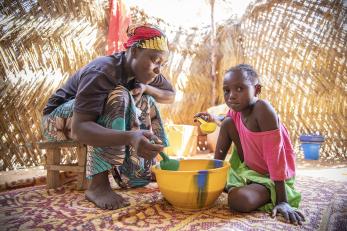
Halima, 26, and her daughter Mahazatou, 7, eat millet porridge in their rural village outside Niger’s capital city, Niamey. Families here rely heavily on agriculture and nearly everyone lives hand-to-mouth. Halima’s family is no exception, and her family often goes without eating — most people here face severe poverty and aren’t able to grow enough food to last them the year. Mercy Corps helps people like Halima by providing millet seeds, cash-for-work to restore farmland, goats and training on agriculture, nutrition and hygiene.
Niger is last on almost every development index, and that poverty was unmistakable while visiting this small remote village. After spending a day with Halima and her family, watching her pull water from an old well, collect firewood from the other side of the nearby river, and arduously grind millet into flour for their daily meal, Halima and her daughter finally had a quiet moment together in a small lean-to to eat. The dappled midday light coming through the woven reeds almost formed a halo behind them.
October 2018, Biu, Nigeria
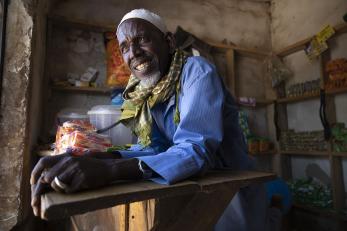
Four years ago, Adamu saw smoke rising from a neighboring village — the ominous sign of a Boko Haram attack. He knew it was time for his family to leave for good. He made sure his wife, five grown children and their spouses, and his grandchild had a spot in a caravan of fleeing vehicles, and when he realized there was no more room, he ran into the bush to make the journey on foot alone. In Biu, Adamu received a Mercy Corps grant that enabled him to expand a small shop, which allows him to feed his large family, especially his grandchildren, whom he loves dearly and affectionately calls his “wealth.” After violence and displacement, Mercy Corps’ work distributing livelihood grants is crucial to helping people recover and rebuild in northeastern Nigeria.
I was struck by Adamu’s indefatigable nature. While describing the horrors he had seen and experienced, he never appeared angry or even sad — he found joy in his grandchildren scampering around his feet at his store, and his smile radiated to everyone in the vicinity. The soft light coming through his shop entrance painted him in a soft warm glow that mirrored his personality and brought out the spark in his eyes.
Thank you
As a member of the Mercy Corps community, you are part of the story each of these photos tells. It’s because of you that our team members around the world are able to help and empower the people in these photos, and many more like them. I’m so grateful to be able to see the impact of your support firsthand — I hope you feel proud knowing that all of this work is possible because of your kindness and compassion.